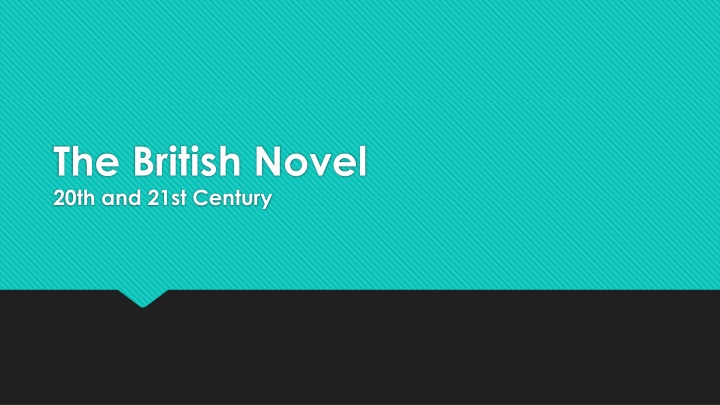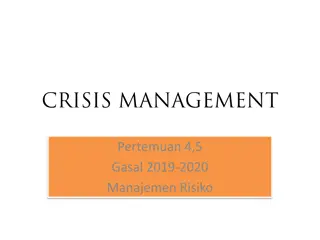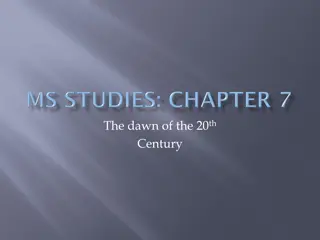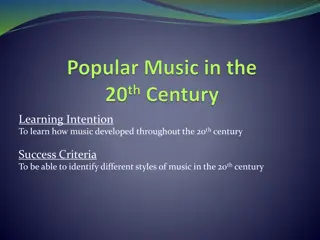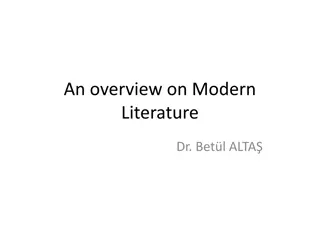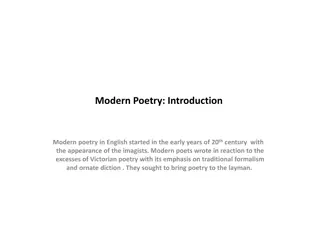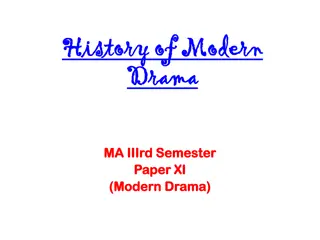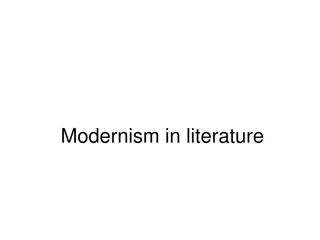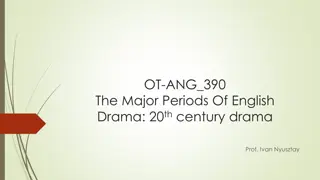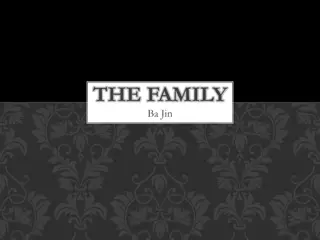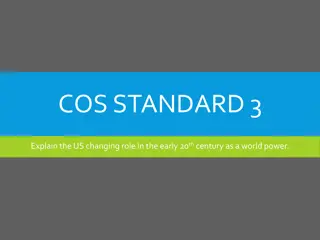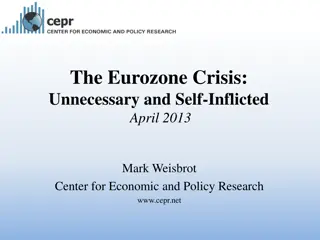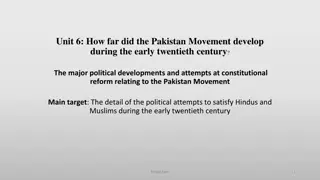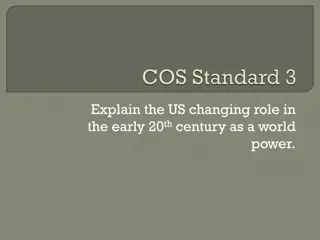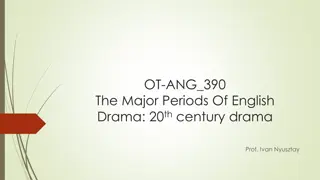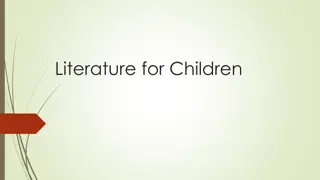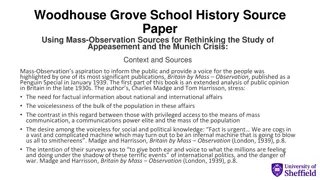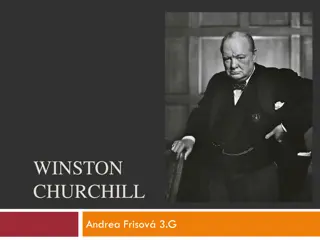Literature of Crisis and Change in Early 20th Century Britain
The 20th century British novel reflected a period of crisis and change, influenced by World War I, economic collapse, rise of fascism, and societal divisions. Writers of the 1930s explored themes of class divisions, sexual repression, and political turmoil, leading to a diverse range of literary expressions. The outbreak of World War II further shaped literary output, with established writers producing notable works capturing the wartime experience.
Download Presentation

Please find below an Image/Link to download the presentation.
The content on the website is provided AS IS for your information and personal use only. It may not be sold, licensed, or shared on other websites without obtaining consent from the author.If you encounter any issues during the download, it is possible that the publisher has removed the file from their server.
You are allowed to download the files provided on this website for personal or commercial use, subject to the condition that they are used lawfully. All files are the property of their respective owners.
The content on the website is provided AS IS for your information and personal use only. It may not be sold, licensed, or shared on other websites without obtaining consent from the author.
E N D
Presentation Transcript
The British Novel 20th and 21st Century
The 1930s World War I created a profound sense of crisis in English culture. This became even more intense with: the worldwide economic collapse of the late 1920s and early 30s, the rise of fascism, the Spanish Civil War (1936 39), the approach of another full-scale conflict in Europe. It is not surprising, therefore, that much of the writing of the 1930s was bleak and pessimistic (i.e.: Evelyn Waugh - Vile Bodies (1930))
The 1930s (2) Divisions of class and the burden of sexual repression became common and interrelated themes in the fiction of the 1930s. Lewis Grassic Gibbon s (pseudonym of James Leslie Mitchell) trilogy A Scots Quair (Sunset Song [1932], Cloud Howe [1933], and Grey Granite [1934]). Walter Greenwood: Love on the Dole (1933) Graham Greene: It s a Battlefield (1934) and Brighton Rock (1938) George Orwell: A Clergyman s Daughter (1935) and Keep the Aspidistra Flying (1936). Elizabeth Bowen: Death of the Heart (1938).
The 1930s (3) The adventurousness of the new generation was shown in part by its love of travel in part by its readiness for political involvement, and in part by its openness to the writing of the avant-garde of the Continent. The writing of the interwar period had great breadth and diversity, from Modernist experimentation to new documentary modes of realism and from art as propaganda (particularly in the theatre) to conventional fiction, drama, and poetry produced for the popular market. Two trends stand out: the impact of film on the writing of the decade, not least on styles of visual realization and dialogue, the ubiquitous preoccupation with questions of time, on the psychological, historical, and even cosmological levels. As the world became less stable, writers sought both to reflect this and to seek some more- fundamental grounding than that provided by contemporary circumstances.
The literature of World War II (193945) The outbreak of war in 1939, as in 1914, brought to an end an era of great intellectual and creative exuberance. Individuals were dispersed; the rationing of paper affected the production of magazines and books; and the poem and the short story, convenient forms for men under arms, became the favoured means of literary expression. No important new novelists or playwrights appeared. In fact, the best fiction about wartime was produced by established writers: Evelyn Waugh s Put Out More Flags (1942), Henry Green s Caught (1943), James Hanley s No Directions (1943), Patrick Hamilton s The Slaves of Solitude (1947), Elizabeth Bowen s The Heat of the Day (1949)
Literature after 1945 Increased attachment to religion most immediately characterized literature after World War II. W.H. Auden turned from Marxist politics to Christian commitment, expressed in poems that attractively combine classical form with vernacular relaxedness. While Graham Greene continued the powerful merging of thriller plots with studies of moral and psychological ambiguity that he had developed through the 1930s, his Roman Catholicism loomed especially large in novels such as The Heart of the Matter (1948) and The End of the Affair (1951). Evelyn Waugh s Brideshead Revisited (1945) and his Sword of Honour trilogy venerate Roman Catholicism as the repository of values seen as under threat from the advance of democracy. Less-traditional spiritual solace was found in Eastern mysticism by Aldous Huxley and Christopher Isherwood.
Fiction The two most innovatory novelists to begin their careers soon after World War II were also religious believers William Golding and Muriel Spark. In novels of poetic compactness, they frequently return to the notion of original sin the idea that, in Golding s words, man produces evil as a bee produces honey. Concentrating on small communities, Spark and Golding transfigure them into microcosms. Allegory and symbol set wide resonances quivering, so that short books make large statements.
Fiction (2) In Golding s first novel, Lord of the Flies (1954), schoolboys cast away on a Pacific island during a nuclear war reenact humanity s fall from grace as their relationships degenerate from innocent camaraderie to totalitarian butchery. In Spark s satiric comedy, similar assumptions and techniques are discernible. Her best- known novel, The Prime of Miss Jean Brodie (1961), for example, makes events in a 1930s Edinburgh classroom replicate in miniature the rise of fascism in Europe. In form and atmosphere, Lord of the Flies has affinities with George Orwell s examinations of totalitarian nightmare, the fable Animal Farm (1945) and the novel Nineteen Eighty- four (1949).
Fiction (3) The stylized novels of Henry Green, such as Concluding (1948) and Nothing (1950), also seem to be precursors of the terse, compressed fiction that Spark and Golding brought to such distinction. This kind of fiction ran antiliberal risks in its preference for allegory, pattern, and symbol over the social capaciousness and realistic rendition of character at which the great 19th- century novels excelled.
Fiction (4) While restricting themselves to socially limited canvases, novelists such as Elizabeth Bowen, Elizabeth Taylor, and Barbara Pym continued the tradition of depicting emotional and psychological nuance that Murdoch felt was dangerously neglected in mid-20th- century novels. In contrast to their wry comedies of sense and sensibility and to the packed parables of Golding and Spark was yet another type of fiction, produced by a group of writers who became known as the Angry Young Men. From authors such as John Braine, John Wain, Alan Sillitoe, Stan Barstow, and David Storey came a spate of novels often ruggedly autobiographical in origin and near documentary in approach. The predominant subject of these books was social mobility, usually from the northern working class to the southern middle class.
Fiction (5) The most inspired fictional cavalcade of social and cultural life in 20th- century Britain was Angus Wilson s No Laughing Matter (1967). The parody and pastiche that Wilson brilliantly deploys in No Laughing Matter and the book s fascination with the sources and resources of creativity constitute a rich, imaginative response to what had become a mood of growing self-consciousness in fiction. Thoughtfulness about the form of the novel and relationships between past and present fiction showed itself most stimulatingly in the works of the academically based novelists Malcolm Bradbury and David Lodge.
Fiction (6) From the late 1960s onward, the outstanding trend in fiction was enthrallment with empire. The first phase of this focused on imperial disillusion and dissolution. In his vast, detailed Raj Quartet, Paul Scott charted the last years of the British in India; he followed it with Staying On (1977), a poignant comedy about those who remained after independence.
Fiction (7) Three half-satiric, half-elegiac novels by J.G. Farrell (Troubles [1970], The Siege of Krishnapur [1973], and The Singapore Grip [1978]) likewise spotlighted imperial discomfiture. Then, in the 1980s, postcolonial voices made themselves audible. Salman Rushdie s crowded comic saga about the generation born as Indian independence dawned, Midnight s Children (1981), boisterously mingles material from Eastern fable, Hindu myth, Islamic lore, Bombay cinema, cartoon strips, advertising billboards, and Latin American magic realism.
Fiction (8) However, not all postcolonial authors followed Rushdie s example. Vikram Seth s massive novel about India after independence, A Suitable Boy (1993), is a prodigious feat of realism, resembling 19th-century masterpieces in its combination of social breadth and emotional and psychological depth. Nor was India alone in inspiring vigorous postcolonial writing. Novelists such as Buchi Emecheta and Ben Okri wrote of postcolonial Africa, as did V.S. Naipaul in his most ambitious novel, A Bend in the River (1979). Nearer England, the strife in Northern Ireland provoked fictional response, among which the bleak, graceful novels and short stories of William Trevor and Bernard MacLaverty stand out.
Fiction (9) Widening social divides in 1980s Britain were also registered in fiction, sometimes in works that purposefully imitate the Victorian Condition of England novel (the best is David Lodge s elegant, ironic Nice Work [1988]). The most thoroughgoing is Margaret Drabble s The Radiant Way (1987). With less documentary substantiality, Martin Amis s novels, angled somewhere between scabrous relish and satiric disgust, offer prose that has the lurid energy of a strobe light playing over vistas of urban sleaze, greed, and debasement. Money (1984) is the most effectively focused of his books.
Fiction (10) Just as some postcolonial novelists used myth, magic, and fable as a stylistic throwing-off of what they considered the alien supremacy of Anglo-Saxon realistic fiction, so numerous feminist novelists took to Gothic, fairy tale, and fantasy as countereffects to the patriarchal discourse of rationality, logic, and linear narrative. The most gifted exponent of this kind of writing, which sought immediate access to the realm of the subconscious, was Angela Carter, whose exotic and erotic imagination unrolled most eerily and resplendently in her short-story collection The Bloody Chamber and Other Stories (1979). Jeanette Winterson also wrote in this vein. Having distinguished herself earlier in a realistic mode, Doris Lessing published a sequence of science fiction novels about issues of gender and colonialism, Canopus in Argos Archives (1979 83).
Fiction (11) Typically, though, fiction in the 1980s and 90s was not futuristic but retrospective. As the end of the century approached, an urge to look back at starting points, previous eras, fictional prototypes was widely evident. The historical novel enjoyed an exceptional heyday. One of its outstanding practitioners was Barry Unsworth, the settings of whose works range from the Ottoman Empire to Venice in its imperial prime and its decadence and northern England in the 14th century. Patrick O Brian attracted an ardent following with his series of meticulously researched novels about naval life during the Napoleonic era, a 20-book sequence starting with Master and Commander (1969) and ending with Blue at the Mizzen (1999).
Fiction (12) Many novels juxtaposed a present-day narrative with one set in the past. A.S. Byatt s Possession (1990) did so with particular intelligence. It also made extensive use of period pastiche, another enthusiasm of novelists toward the end of the 20th century. Adam Thorpe s striking first novel, Ulverton (1992), records the 300-year history of a fictional village in the styles of different epochs. In addition to the interest in remote and recent history, a concern with tracing aftereffects became dominatingly present in fiction. Most subtly and powerfully exhibiting this, Ian McEwan grew into imaginative maturity with novels set largely in Berlin in the 1950s (The Innocent [1990]) and in Europe in 1946 (Black Dogs [1992]). These novels scenes set in the 1990s are haunted by what McEwan perceives as the continuing repercussions of World War II.
The 21st Century As the 21st century got underway, history remained the outstanding concern of English literature. Although contemporary issues such as global warming and international conflicts received attention, writers were still more disposed to look back. Bennett s play The History Boys premiered in 2004; it portrayed pupils in a school in the north of England during the 1980s. Although Cloud Atlas (2004) by David Mitchell contained chapters that envisage future eras ravaged by malign technology and climactic and nuclear devastation, it devoted more space to scenes set in the 19th and early 20th centuries. In doing so, it also displayed another preoccupation of the 21st century s early years: the imitation of earlier literary styles and techniques. There was a marked vogue for pastiche and revisionary Victorian novels.
